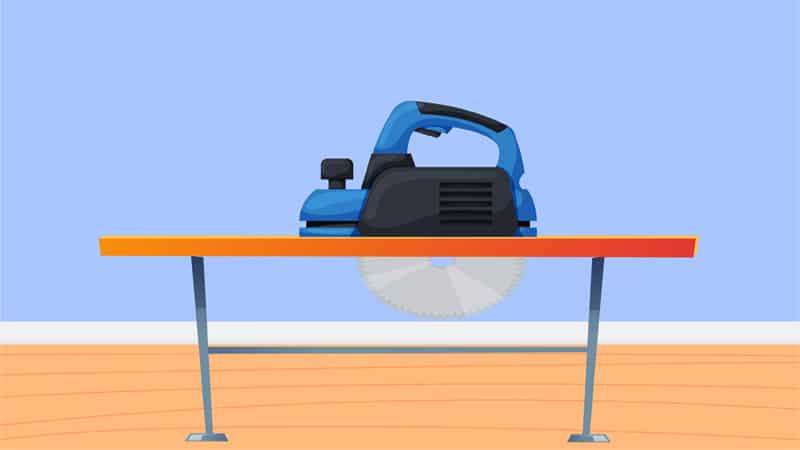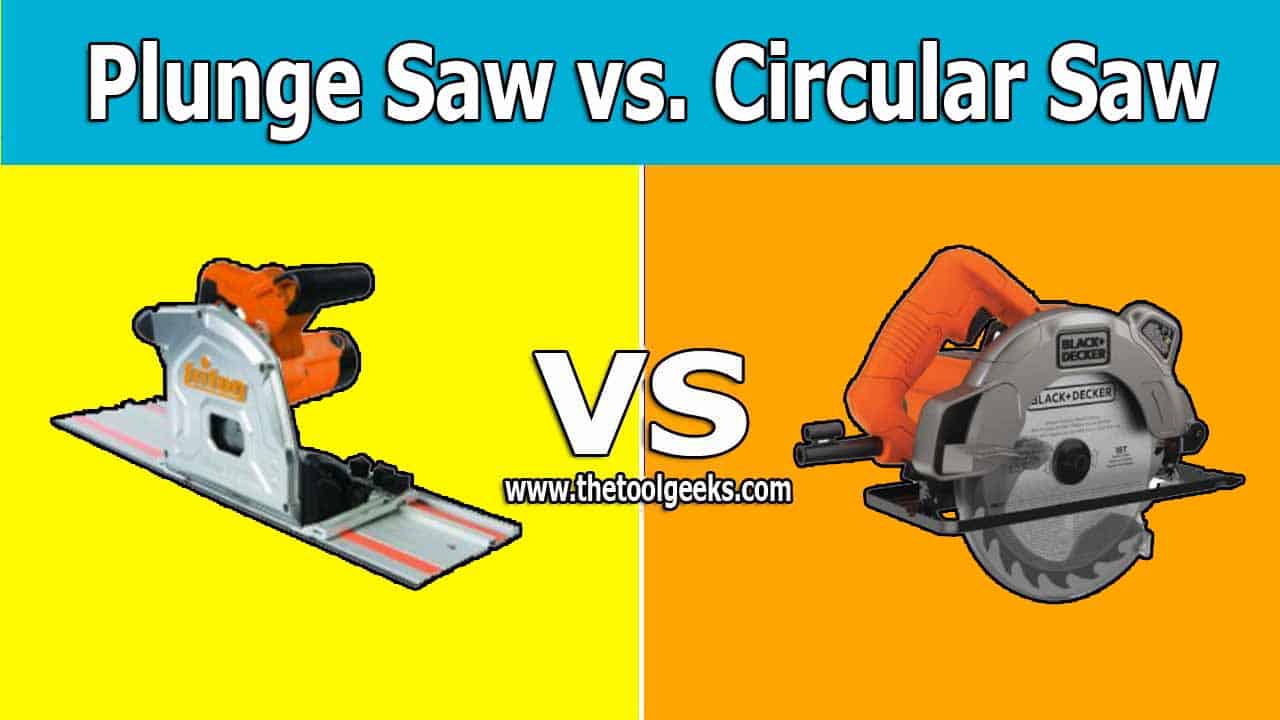Plunge Saw vs. Circular Saw: Do You Need Both?
TheToolGeeks.com is a participant in the Amazon Services LLC Associates Program and other affiliate advertising programs. We may earn from qualifying purchases. (Learn More).
Both the circular saw and the plunge saw are power tools that can cut through just about any plank, log, or wooden material. Common questions are: “what is the difference between a circular saw and a plunge saw?” or “which one of these saws is better?” or “can I use one in place of other” or “can I get by with just one or do I need both?”
Overall, the main differences between the plunge saw and the circular saw include the cost between both saws, the blade sizes of each one, the track on the plunge saw, and the fact that the plunge saw makes more accurate cuts than the circular saw while the circular saw is more powerful than the plunge saw.
| Saw Type: | Plunge (Track) | Circular |
| Use: | Sawing Plywood & Boards, | Sawing Plywood & Boards |
| Operation: | Start Anywhere in the Board | Start at the Board End |
| Power Level: | More Powerful | Less Powerful |
| Precision Level: | Less Precise | More Precise |
| Blade Size: | Average is 6-1/2 to 7-1/4 Inches | Average is 5-1/2 to 6-1/2 Inches |
| Cutting Depth: | Average is 2 to 4 Inches | Average is 1-1/2 to 3 Inches |
| Power Type: | Corded and Cordless | Corded and Cordless |
| Price Range: | More Affordable | More Expensive |
Keep reading to learn the advantages and differences of each saw type, plus their main uses, and to determine which saw is best for your needs, or if you truly need both.
Jump To Page Contents:
Plunge Saw vs. Circular Saw – My Lists
If you’re already familiar with both saw types, there here’s my recommend lists:
What is a Plunge Saw?
The plunge saw is commonly called a track saw. This is because the saw is placed on a long plate that looks like a track field for athletes. This track or rail serves as a guide to the saw while cutting.

The saw uses a spinning motion generated by the motor to cut materials. The plunge saw is perfect for making accurate straight and complex cuts on wood. The plunge saw like most power tools also comes in both cordless (battery-operated) and corded models.
This saw uses a disc-shaped blade that protrudes beneath the saw. The level at which it protrudes is called “depth.”
The depth of the blade can be increased or decreased depending on the task and the cutting result you want to get. Any of the “DEWALT” or “MAKITA” plunge saw series would be a good choice if you are in the market for a plunge saw.
What Does a Plunge Saw Look Like?
The plunge saw is a type of circular saw. It saw looks like a pressing iron placed on a track or rail. The track on a plunge saw is a thin long plate that varies in size and length.
The function of the rail is that it guides the cutting action of the blade. The handle of the plunge saw is located at the front, top, or side of the saw depending on the model you have.
The saw has a “depth gauge” used to adjust or set the depth of the plunge. The depth gauge is usually located on the side of the saw or near the blade.
The plunge saw uses a circular blade that protrudes below the saw and is guided by a metallic plate called the shoe. The plunge saw also has a dust-collection port at the back of the saw that helps to reduce dust. The plunge saw doesn’t have a blade guard because the blade is encased inside the saw.
What Is a Circular Saw?
The circular saw is a very popular and versatile power tool found in virtually every woodworking shop. The saw also uses a spinning motion generated by the motor to cut through a wide array of materials.

It is designed to use a disc or circle-shaped blade to make crosscuts and rip through boards. The basic feature of this saw is that it doesn’t make smooth cuts.
The blade used with a circular saw is very aggressive and thick which means the circular saw isn’t suited for making smooth and clean cuts.
If what you need is a clean finish, the circular saw might not be your best bet. The circular saw also comes in both corded circular saw and cordless (battery-operated) models.
What Does a Circular Saw Look Like?
The basic difference in appearance between the plunge saw and circular saw is the track or rail that comes with the plunge saw.
Besides this, both saws are alike. At first glance, the circular saw looks like a big round metallic object. The circular saw doesn’t have a dust collection port.
Instead, the dust just escapes through an opening on the side of the saw. The circular saw also uses a disc or circular blade that protrudes below the saw and it’s guided by a metallic plate called the shoe.
The circular saw is designed with a blade guard that protects and covers the blade when not in use. The saw has an adjustment knob on the back that you can use to change the speed of the blade if need be.
Read More — Mini Circular Saws ReviewPlunge Saw vs. Circular Saw – Buying Guide
The Finishing
The plunge saw makes cleaner and more accurate cuts than the circular saw. This is because of the track-feature on the saw. The track or sail guides the cutting process making the finish on your cuts smooth and fine.
The finish on the cuts made by a circular saw is not as smooth or fine as the cuts made with a plunge saw. With a circular saw, there isn’t any track or rail to guide the blade while cutting.
You largely guide the cutting process yourself. This makes straight cuts difficult on the circular saw.
Read More — Cordless vs Corded Circular Saw?The Kerf of the Blade
The kerf is used to describe the space left in the material after your blade goes through it. In other words, this is the amount of material that is turned into sawdust when you cut the wood. The bigger the blade, the more space between the material.
Flexibility and Accuracy
Due to their designs, the flexibility and accuracy are different for both of these tools. The circular saw can make angled cuts, straight cuts, curved cuts, and it’s a very flexible tool.
On the other hand, the plunge saw can only make straight cuts due to its design. But, the plunge saw is more accurate than the circular saw. In fact, you need a lot of experience to be able to make an accurate cut with a circular saw.
Safety
Both of these tools are safe, as long as you use protection gears, and follow the manual instructions. But, if we compare both tools, then the plunge saw is safer. That’s because the blade is under the table and the track only allows the blade to move forward.
Dust Management
As a woodworker, you will deal with dust a lot. Both of these two tools are great at managing the dust. But, the plunge saw is slightly better, and that’s because of its design. The plunge saw has the blade under the table and all the dust also goes under the table. The user will see little to no dust while working.
Budget
If you compare the price of both tools, the plunge saw costs a little more than a circular saw. But, it also depends on the brand you are choosing and the features the tool has.
The Advantages of Using the Plunge Saw Over a Circular Saw
- The plunge saw is used for making straight cuts, cross cuts, angled cuts, and other cuts that would be rather difficult to make using other types of power cutting tools.
- It reduces the possibility of injuries since the blade is encased in the saw.
- It reduces dust around your work station.
- It is good for making deep cuts on wood since the depth can be adjusted to make deeper cuts.
- You can start cutting from any part of the wood or plank based on the track-feature of the plunge saw.
The Advantages of Using a Circular Saw Over the Plunge Saw
- The tough blade of the circular saw means it’s perfect for ripping boards.
- The size of the circular saw makes it portable.
- The circular saw is a fast power tool for cutting a large amount of material.
- The circular saw is more suited for cutting through tougher materials like metal and concrete.
Recommendations and My Lists Again
If your budget allows only one or you want to start with just one of the saw types:
- For the average homeowner and DIYer, and construction-type contractor, we recommend the Circular saw for general board ripping and occasional cutting tasks due to it’s generally larger blade size, higher power, more affordable price. Most Circular Saws come with their own connected guide assembly and LED lights to help you saw along straight-line measured cuts when needed.
- For the avid woodworker, serious DIYer, and wood-focused contractor, we recommend the Plunge Track saw for both plywood ripping, precise cutting, and frequent sawing tasks due to its track-precision cutting design, medium blade size, and dust containment features that come at a higher price. Typically, you’ll also have a table saw or even a band saw for those large cutting jobs.
And if your budget allows for both, then we recommend:
- A larger-blade Circular saw for general board ripping while a smaller-blade Plunge saw with medium-length tracks and dust control for precise cuts.
Hopefully this article has helped you answer the question and if you’re ready to buy, here’s my recommend lists:
Amazon and the Amazon logo are trademarks of Amazon.com, Inc, or its affiliates.
















